Miniature Christmas light sets changed over the years to adapt to stricter safety standards.
By knowing this you can determine when your set was made.
![]()
Miniature Christmas light sets changed over the years to adapt to stricter
safety standards.
By knowing this you can determine when your set was made.
Start by examining the plug.
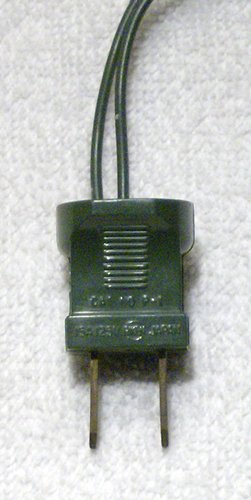 |
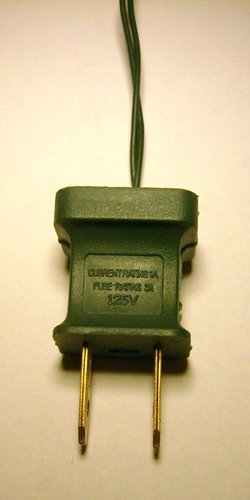 |
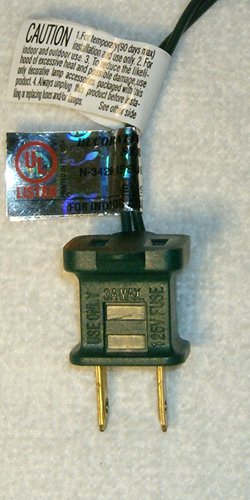 |
| 1 - Non fused pre 1977. | 2 - Fusible link 1977 - 1990. | 3 - Replaceable fuses post 1987. (Roll cursor over photo) |
Photo 1 shows a non fused plug used prior to 1977 marked "15A 125V JAPAN".
This type of plug was used on miniature light sets before fuse protection was
required.
Photo 2 shows a fusible link plug used from 1977 to present, mostly on the
cheap sets. It is marked
"Current rating 1A, fuse rating 3A, 125V"
On this type of plug there is no door to access the fuses. That's because there
are two non replaceable fusible links inside the plug.
A fusible link is a short length of fuse wire inside the plug that provides over
current protection.
Photo 3 shows the now standard plug with replaceable fuses, used from 1987 to
present .
This plug is marked "use only 3A max 125V fuse". Roll your cursor over the photo
to open the fuse door.
Inside this plug are two replaceable 3.5 millimeter diameter by 10 millimeter
micro fuses, typically 3 amps.
At the same time Underwriters labs introduced the silver holographic
certification tag. The hologram is visible in blue.
![]()
Now examine the sockets
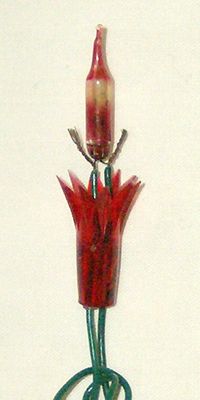 |
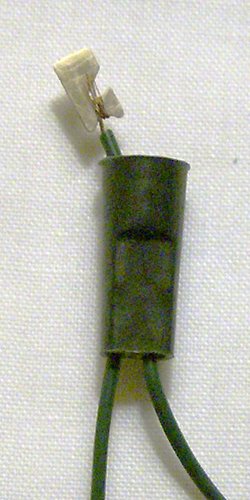 |
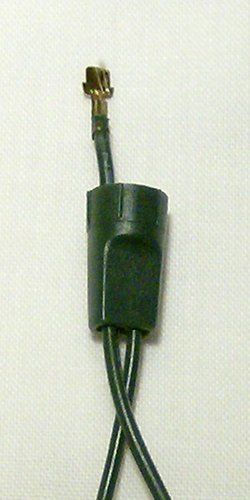 |
|
1- Spliced connection. 1950s ? |
2- Wire wrapped contact |
3- Crimped contact |
Photo 1 In some early miniature sets, there were no sockets, the
bulbs were spliced directly to the wires!
From the Cactus lights set. This design is
found on early imported miniature sets made around the 1950s to 1960s.
Photo 2 shows an old style socket with the wire
simply wrapped around the contact, which is then inserted into the socket.
From the 15 light Yuletide set. This
design is typical of sets from Taiwan made before 1977.
Photo 3 shows a socket with crimped contacts. This was required due to safety regulations that specified that the wire and insulation be solidly attached to the contact. The contact is also barbed, or shaped so it cannot easily come out of the socket.
![]()
Now examine the Bulbs.
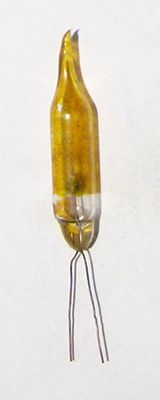 |
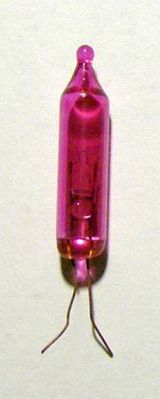 |
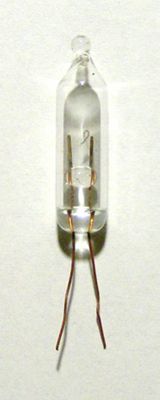 |
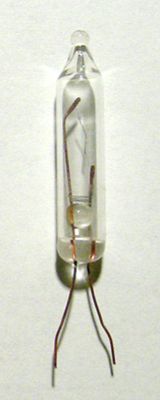 |
| 1- Drawn Tip | 2- Arched Filament | 3- Kinked Filament | 4- Vertical Filament |
The design of the bulbs also changed over the years.
Starting from the left, bulb #1 is an early miniature bulb that has the exhaust
tip drawn out into a point, which presented a safety problem.
If you smacked your hand down on the bulb, it could puncture your skin! This
design was discontinued around 1977, maybe earlier and changed to the short ball
tip seen in bulbs 2, 3, and 4.
Next, bulb #2 is an old school bulb, with the filament strung horizontally and formed
into an arch. The problem with this design is that the filament would sometimes
kink, as seen in bulb #3. This resulted in reduced light output, hot
spots, and shortened life for the other bulbs in the string.
Bulb #4 is a modern design introduced first on the better brands like G.E. then
others later with
the filament strung lengthwise. This solves the previously mentioned problems.
![]()
Here are some more tips to help in dating the vintage of a set.
![]() ZIP codes were introduced in
1963 and the ZIP+4 code in 1983 for decorations sold in the U.S.A.
ZIP codes were introduced in
1963 and the ZIP+4 code in 1983 for decorations sold in the U.S.A.
![]() U.P.C. bar codes were invented in 1973 and
introduced in 1974 but did not gain widespread use until a few years later.
U.P.C. bar codes were invented in 1973 and
introduced in 1974 but did not gain widespread use until a few years later.
Source : Wikipedia
< Prev page | Home | Next page >
Bulb base identification.
Miniature Christmas light bulbs were made in a variety of base
designs over the years.
The chart below identifies the ones I have come across.
| 1/4 inch wedge base. This is the most common base style in use. The 1/4 inch diameter refers to the round part of the base that enters the socket. |
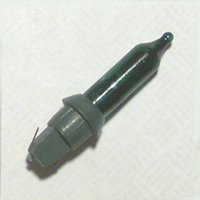 |
| 7 Millimeter wedge base. Used on sets made to metric standards, it's slightly larger than the 1/4 inch size shown above. |
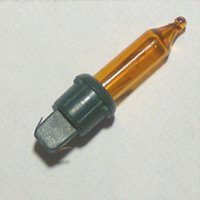 |
| 7 Millimeter wedge base with locking clip. The tab keeps the bulb from coming loose from the socket. |
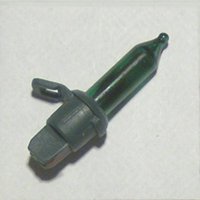 |
| Italian lights by Kurt S. Adler. Used on "Fairy Lights" made in Italy this style is smaller than the typical base at 5.5 millimeters, or 7/32 inch in diameter, with an oval shaped contact section. The entire bulb is only 24 millimeters, or 15/16 inch long. |
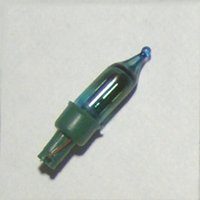 |
| Santa's World by Kurt S. Adler. This base is unique because the wires are bent against the narrow part of the wedge, rather than the wide part. |
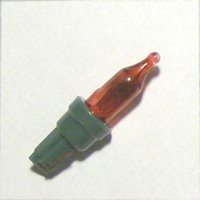 |
| 1/4 inch wedge base with tail. Used on heavy duty and constant on sets, the tail is added to keep the contacts in the socket from shorting against each other. If a bulb should come out, the contacts in the socket close to maintain current flow. |
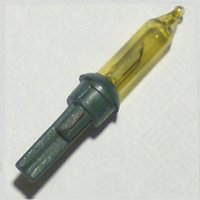 |
| General Electric Merry Midget 1963 - 1978. A variation on this 2 pin base was also used on NOMA miniature sets. |
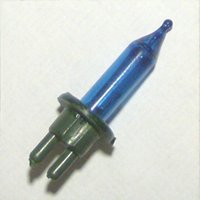 |
| Another variation on the 2 pin base, this one has square pins. Manufacturer not known. | 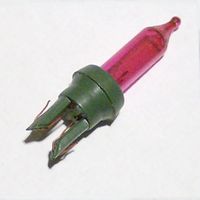 |
| Combination wedge base/ reflector, NOEL standard, petal
style. The most popular reflector style, it resembled a miniature Tulip flower. |
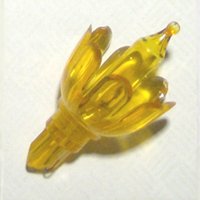 |
| Combination wedge base/
reflector, NOEL standard, petal style. This one has finer petals and is called a badminton reflector. |
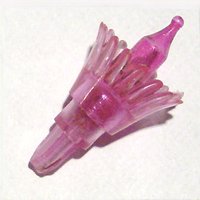 |
| Combination wedge base/
reflector, NOEL standard, star style. This reflector was more resistant to breakage, but the points would snag on the wires and stepping on it in stocking feet was quite painful ! |
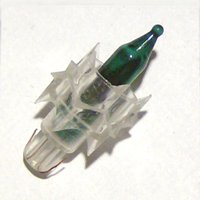 |
| Combination wedge base/ reflector, NOEL standard, fluted
style. This style reflector was used exclusively on tree toppers. |
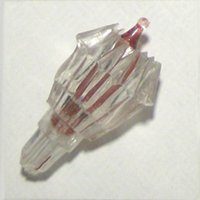 |
Identification of Edison base bulbs.
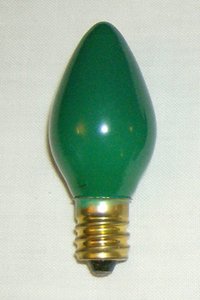 |
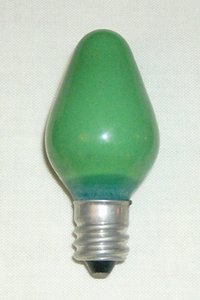 |
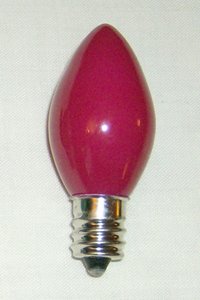 |
|
Brass Base |
Aluminum Base |
Nickel Base |
For Edison base bulbs you can tell when they were made by knowing what metal the
base is made of.
Brass Base - Used throughout the history of bulb making, but today used
mostly on lesser quality brands because brass tarnishes easily.
Aluminum Base - Introduced by G.E. and Westinghouse in the late 1950s.
More resistant to corrosion, Aluminum is a dull silver color.
Nickel Base - Introduced about 1990 by G.E. and others, has excellent
resistance to corrosion. Nickel is a bright silver color.
The next page showcases vintage sets.